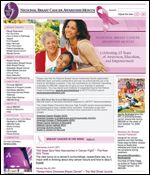October Is National Breast Cancer Awareness Month
The National Breast Cancer Awareness Month (NBCAM) organization, which began its campaign in 1984, is a partnership of more than a dozen national professional medical associations, public service organizations, and government agencies that work together year-round to promote awareness of breast cancer, share up-to-date information about the disease, and provide greater access to screening services.

The National Breast Cancer Awareness Month (NBCAM) organization, which began its campaign in 1984, is a partnership of more than a dozen national professional medical associations, public service organizations, and government agencies that work together year-round to promote awareness of breast cancer, share up-to-date information about the disease, and provide greater access to screening services. The NBCAM board of sponsors includes the Centers for Disease Control and Prevention; the American Cancer Society and National Cancer Institute; the Oncology Nursing Society and the American Society of Clinical Oncology; patient advocacy groups such as CancerCare and Susan G. Komen for the Cure; and a number of other leading medical specialty groups. Visit the NBCAM website at www.nbcam.org for information to share with patients about different breast cancer subtypes and stages, support such as prescription-assistance programs and access to educational materials, and current media coverage of breast cancer. A wide range of breast cancer–related resources for patients and professionals also can be found on the websites of the NBCAM board of sponsors. Selected links are provided below.
• Oncology Nursing Society: Clinical Practice Resources >
Breast Cancer– Available at: http://www.ons.org/ClinicalResources/BreastCancer
• American Society of Clinical Oncology: Clinical Practice Guidelines >
Breast Cancer– Available at:http://www.asco.org/ascov2/Practice+&+Guidelines/Guidelines/Clinical+Practice+Guidelines/Breast+Cancer
• American Cancer Society: Guidelines for the Early Detection of Cancer >
Breast Cancer– Available at: http://www.cancer.org/Healthy/FindCancerEarly/CancerScreeningGuidelines/index
• Centers for Disease Control and Prevention: Breast Cancer Screening–
Available at: http://www.cdc.gov/cancer/breast/basic_info/screening.htm
• National Cancer Institute: FactSheet > Mammograms–
Available at:http://www.cancer.gov/cancertopics/factsheet/detection/mammograms
Newsletter
Stay up to date on recent advances in the multidisciplinary approach to cancer.